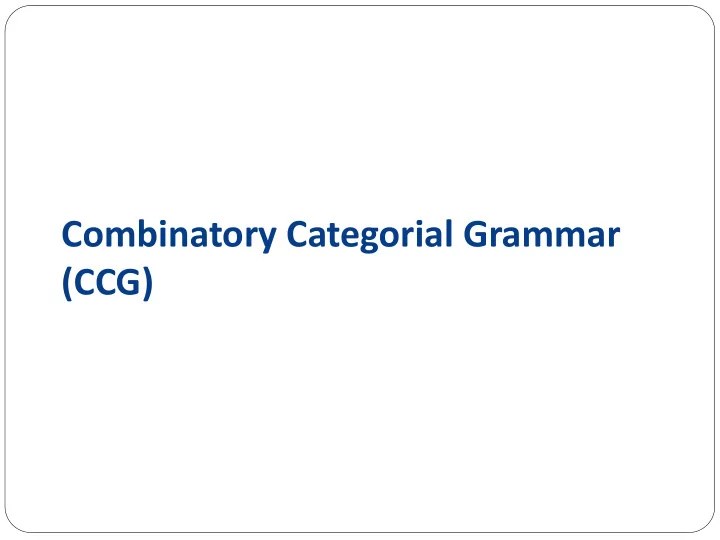

Combinatory Categorial Grammar (CCG)
Categories Categories = types Primitive categories N, NP, S, PP, etc Functions a combination of primitive categories S/NP, (S/NP) / (S/NP), etc V, VP, Adverb, PP, etc
Combinatory Rules Application forward application: x/y y x backward application: y x\y x Composition forward composition: x/y y/z x/z backward composition: x\y y\z x\z forward crossing composition: x/y y\z x\z backward crossing composition: x\y y/z x/z Type-raising forward type-raising: x y / (y\x) backward type-raising: x y \ (y/x) Coordination <&> x conj x x
Combinatory Rules 1 : Application Forward application “>” X/Y Y X (S\NP) / NP NP S\NP Backward application “<“ Y X\Y X NP S\NP S
Function likes := (S\NP) / NP A transitive verb is a function from NPs into predicate S. That is, it accepts two NPs as arguments and results in S. VP or intransitive verb: S\NP Transitive verb: (S\NP) / NP Adverb: (S\NP) \ (S\NP) PP: ((S\NP) \ (S\NP)) / NP (NP\NP) / NP
CCG Derivation: CFG Derivation: Examples from Prof. Julia Hockenmaier
Combinatory Rules Application forward application: x/y y x backward application: y x\y x Composition forward composition: x/y y/z x/z backward composition: x\y y\z x\z forward crossing composition: x/y y\z x\z backward crossing composition: x\y y/z x/z Type-raising forward type-raising: x y / (y\x) backward type-raising: x y \ (y/x) Coordination <&> x conj x x
Combinatory Rules 4 : Coordination X conj X X Alternatively, we can express coordination by defining conjunctions as functions as follows: and := (X\X) / X
Coordination with CCG Examples from Prof. Mark Steedman
Coordination with CCG Application forward application: x/y y x backward application: y x\y x
Coordination with CCG Application forward application: x/y y x backward application: y x\y x
Combinatory Rules Application forward application: x/y y x backward application: y x\y x Composition forward composition: x/y y/z x/z backward composition: x\y y\z x\z forward crossing composition: x/y y\z x\z backward crossing composition: x\y y/z x/z Type-raising forward type-raising: x y / (y\x) backward type-raising: x y \ (y/x) Coordination <&> x conj x x
Coordination with CCG Application forward application: x/y y x backward application: y x\y x Composition forward composition: x/y y/z x/z backward composition: x\y y\z x\z forward crossing composition: x/y y\z x\z backward crossing composition: x\y y/z x/z
Coordination with CCG Application forward application: x/y y x backward application: y x\y x Composition forward composition: x/y y/z x/z backward composition: x\y y\z x\z forward crossing composition: x/y y\z x\z backward crossing composition: x\y y/z x/z
Combinatory Rules Application forward application: x/y y x backward application: y x\y x Composition forward composition: x/y y/z x/z backward composition: x\y y\z x\z forward crossing composition: x/y y\z x\z backward crossing composition: x\y y/z x/z Type-raising forward type-raising: x y / (y\x) backward type-raising: x y \ (y/x) Coordination <&> x conj x x
Combinatory Rules 3 : Type-Raising Turns an argument into a function Forward type-raising: X T / (T\X) Backward type-raising: X T \ (T/X) For instance… Subject type-raising: NP S / (S \ NP) Object type-raising: NP (S\NP) \ ((S\NP) / NP)
Combinatory Rules 3 : Type-Raising Application forward application: x/y y x backward application: y x\y x Type-raising forward type-raising: x y / (y\x) backward type-raising: x y \ (y/x) Subject type-raising: NP S / (S \ NP) Object type-raising: NP (S\NP) \ ((S\NP) / NP) Coordination <&> x conj x x
Combinatory Rules 3 : Type-Raising
Tree Adjoining Grammar (TAG) Some slides are from Prof. Julia Hockenmaier
TAG rule 1: Substitution
TAG rule 2: Adjunction
The effect of adjunction
Example: TAG Lexicon
Example: TAG Derivation
Example: TAG Derivation
Example: TAG Derivation
Cross-serial Dependencies Dutch and Swiss-German Comparison to regular grammar and CFG?
Recommend
More recommend